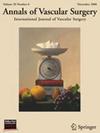Carotid Artery Stenting Using Sheathless 8Fr Optimo Balloon Guide Catheter System via Transradial Access
IF 1.4
4区 医学
Q3 PERIPHERAL VASCULAR DISEASE
引用次数: 0
Abstract
Background
The transradial approach (TRA) is a less invasive alternative for carotid artery stenting (CAS). However, limited device availability has restricted its application, and reports on balloon guide catheters (BGCs) in TRA are scarce. This study reports the initial experience with sheathless 8Fr BGC in CAS via TRA.
Methods
We retrospectively analyzed cases of CAS performed with a sheathless 8Fr Optimo BGC (Tokai Medical Products, Aichi, Japan) via TRA from April 2023 to November 2024. Patient demographics, procedural details, and outcomes were evaluated. The primary efficacy endpoint was the technical success rate, while the primary safety endpoint was a composite of major access-related complications, stroke, myocardial infarction, and death within 30 days.
Results
A total of 30 cases were included (median age 77 years; 90% male). Symptomatic lesions were present in 42%, with a median stenosis rate of 79%, and 63% involved the right carotid artery. Sheathless BGC insertion and navigation succeeded in 29 cases (97%), with 1 case (3%) requiring conversion to brachial access due to radial artery spasm. Balloon inflation for flow control and device stabilization was performed in 23 cases (77%). CAS was successful in all cases, with no major complications or adverse events.
Conclusion
Our experience suggests that the sheathless 8Fr BGC is safe and feasible for CAS via TRA. This approach preserves the minimally invasive nature of TRA while improving device stability and potentially reducing embolic risk. Further development of TRA-specific low-profile devices may enhance procedural outcomes and broaden adoption in neurointervention.
经桡动脉通路应用无鞘8Fr Optimo球囊导管系统置入颈动脉支架
经桡动脉入路(TRA)是颈动脉支架植入术(CAS)的一种侵入性较小的选择。然而,有限的设备可用性限制了其应用,并且关于球囊引导导管(bgc)在TRA中的报道很少。本研究报告了经TRA治疗CAS无鞘8Fr BGC的初步经验。方法回顾性分析2023年4月至2024年11月间使用无鞘8Fr Optimo BGC (Tokai Medical Products,爱知,日本)经TRA行CAS的病例。对患者人口统计、手术细节和结果进行评估。主要疗效终点是技术成功率,而主要安全性终点是主要通路相关并发症、卒中、心肌梗死和30天内死亡的综合指标。结果共纳入30例,中位年龄77岁;90%的男性)。42%出现症状性病变,中位狭窄率为79%,63%累及右侧颈动脉。无鞘BGC插入和导航成功29例(97%),1例(3%)由于桡动脉痉挛需要转换为肱通道。23例(77%)采用球囊充气进行流量控制和装置稳定。所有病例均成功,无重大并发症或不良事件发生。结论无鞘8Fr BGC经TRA行CAS是安全可行的。这种方法保留了TRA的微创性,同时提高了设备的稳定性,并潜在地降低了栓塞风险。tra专用的低姿态装置的进一步发展可能会提高手术效果,并扩大神经干预的应用范围。
本文章由计算机程序翻译,如有差异,请以英文原文为准。
求助全文
约1分钟内获得全文
求助全文
来源期刊
CiteScore
3.00
自引率
13.30%
发文量
603
审稿时长
50 days
期刊介绍:
Annals of Vascular Surgery, published eight times a year, invites original manuscripts reporting clinical and experimental work in vascular surgery for peer review. Articles may be submitted for the following sections of the journal:
Clinical Research (reports of clinical series, new drug or medical device trials)
Basic Science Research (new investigations, experimental work)
Case Reports (reports on a limited series of patients)
General Reviews (scholarly review of the existing literature on a relevant topic)
Developments in Endovascular and Endoscopic Surgery
Selected Techniques (technical maneuvers)
Historical Notes (interesting vignettes from the early days of vascular surgery)
Editorials/Correspondence

 求助内容:
求助内容: 应助结果提醒方式:
应助结果提醒方式:


